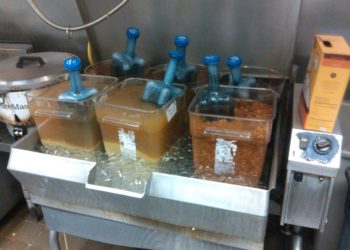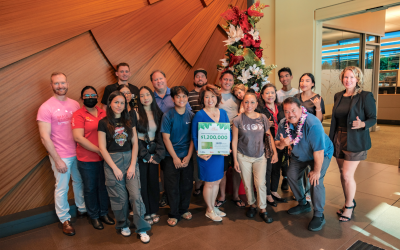With the summer heat, there are lots of ways to cool yourself down. Cooked foods have lots of ways to cool off as well. Here is the why and how of cooling foods.
Today, the kitchen made 5 gallons of Loco Moco Gravy and 20 pounds of your famous Pineapple Coleslaw. The Temperature Danger Zone (TDZ) is between 41 and 135 degrees. Foods in this temperature range are at the greatest risk of pathogenic bacteria growth (that’s the bad ones) Getting these foods out of the TDZ is critical, and one that the DoH will want to see is being properly done.
Gravies are usually stored in 5 gallon buckets. The best procedure is to place the bucket in  a ice/water bath, and stir frequently In order to mix the cooled product into the still hot. An additional tool is use of Ice Wands. These plastic wands are filled with water, and left in the freezer to become solid (Proper storage of ice wands is in/on a sanitized surface – not on the floor or laying on a shelf) When they are inserted in the sauce, the ice in the wand melts while transferring the cold to the product. Attached is a photo I took of a perfect cooling setup.
a ice/water bath, and stir frequently In order to mix the cooled product into the still hot. An additional tool is use of Ice Wands. These plastic wands are filled with water, and left in the freezer to become solid (Proper storage of ice wands is in/on a sanitized surface – not on the floor or laying on a shelf) When they are inserted in the sauce, the ice in the wand melts while transferring the cold to the product. Attached is a photo I took of a perfect cooling setup.
The coleslaw is best spread into smaller pans – up to 2 inches thick. These pans should be loosely covered then placed into refrigeration. Occasional stirring helps cool it down. Sauces can be cooled this way as well. The 2 inches allows greater surface area to be exposed to cold, temps, and the cold penetrates into the food quicker
Recording of temps is an important part of this procedure. Foods need to be cooled from 135 to 70 within 4 hours, and then from 70 to 41 in 2 hours. Use of cooling logs is recommended. This recordkeeping step allows the kitchen to be aware of, observe and correct any improper cooling temps, plus the records kept on file are proof foods were properly cooled. Review of these logs by your management temp can identify foods that are not being properly cooled, and will need adjustment to your procedures
Once the foods are cooled to under 41, they can be transferred to storage pans or buckets, labeled, covered and put away.
A Do Not is to place buckets with hot or boiling sauces into the walkin or freezer. That overloads the machinery, which can result in a breakdown.
To learn more detail about this and other Food Safety procedures, or to set up an independent discounted audit of your facility, please contact Peter Bellisario of PeterB Food Safety Audits at peterb101@aol.com or (808)491-7766.




0 Comments